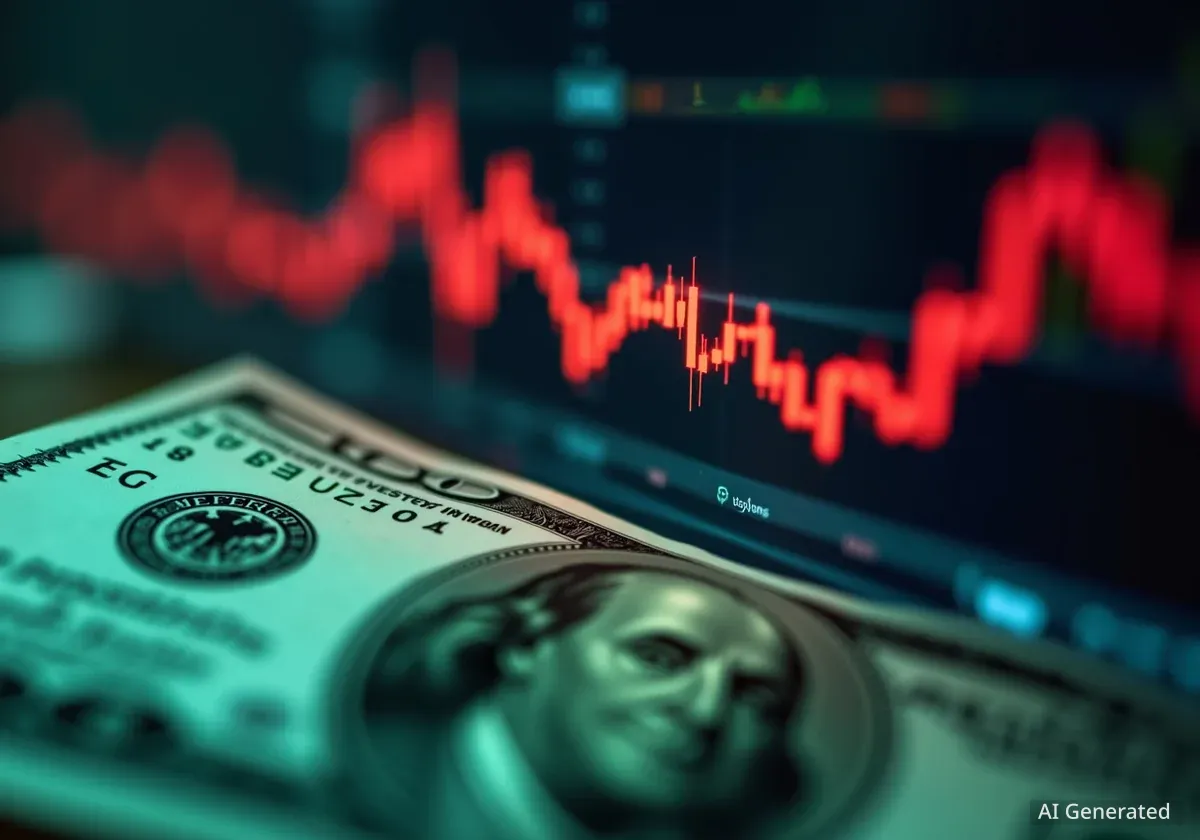The euro has weakened against the U.S. dollar, pulling back from a recent four-year high, following the release of disappointing business sentiment data from Germany. The key economic indicator fell to its lowest level in four months, raising concerns about the health of the Eurozone's largest economy and putting downward pressure on the common currency.
The currency pair, EUR/USD, moved towards the $1.178 mark after the data was published. This represents a significant retreat from the peak of $1.192 reached on September 17. The decline highlights the market's sensitivity to economic indicators from Germany, which often serves as a barometer for the entire Eurozone.
Key Takeaways
- The euro weakened against the U.S. dollar, trading near $1.178, down from a recent four-year high of $1.192.
- Germany's Ifo Business Climate Index for September fell to 87.7, below the market forecast of 89.3 and its lowest reading since May.
- The data contrasts with a recent PMI survey showing expansion in the Eurozone's services sector but contraction in manufacturing.
- Investor focus is also on U.S. Federal Reserve policy, with markets pricing in a high probability of an October rate cut.
German Business Sentiment Hits Four-Month Low
The primary catalyst for the euro's decline was the latest report from the Ifo Institute for Economic Research. The Ifo Business Climate Index for Germany dropped by 1.2 points to 87.7 in September. This figure was notably below the consensus market expectation, which had predicted a reading of 89.3.
The September result marks the lowest level for the index since May, indicating a significant deterioration in business morale. The index is a closely watched survey of approximately 9,000 German businesses in manufacturing, services, trade, and construction, making it a critical gauge of economic health.
September Ifo Index Details
- Actual Reading: 87.7
- Market Forecast: 89.3
- Change: -1.2 points
- Significance: Lowest level since May
A lower Ifo reading suggests that German companies are becoming more pessimistic about the current business situation and their expectations for the next six months. This pessimism can translate into reduced investment and hiring, potentially slowing down economic growth not just in Germany but across the Eurozone.
Broader Eurozone Economic Picture Remains Mixed
The downbeat Ifo report followed a more mixed set of data from the broader Eurozone. A recent HCOB Purchasing Managers' Index (PMI) survey presented a divergent economic picture for the currency bloc in September.
According to the survey, the Eurozone's private sector continued to expand, driven primarily by a resilient and stronger-than-expected performance in the services sector. This suggests that consumer-facing businesses are still holding up relatively well.
Understanding PMI Data
The Purchasing Managers' Index (PMI) is an economic indicator derived from monthly surveys of private sector companies. A reading above 50 indicates expansion in the sector compared to the previous month, while a reading below 50 indicates contraction.
However, the positive news from the services industry was offset by weakness in another key area. The same PMI survey revealed that the manufacturing sector slipped back into contraction. This divergence highlights an ongoing challenge for the European Central Bank (ECB), as different parts of the economy are moving in opposite directions.
The weakness in manufacturing, a critical component of the German economy, combined with the poor Ifo sentiment data, appears to have outweighed the positive signals from the services sector in the minds of currency traders.
Federal Reserve Policy and US Data in Focus
While European data was the main driver of the euro's recent movement, developments in the United States are also playing a crucial role. Investors are closely monitoring statements from the U.S. Federal Reserve and upcoming economic data for clues about the future path of interest rates.
Fed Chair Jerome Powell recently reiterated a cautious stance on future monetary policy decisions. In his remarks, he highlighted persistent inflation pressures, partly stemming from tariffs, and signs of a softening labor market. This cautious tone has led many investors to believe that the central bank is leaning towards easing policy.
"The market is interpreting the Federal Reserve's cautious commentary as a signal that a rate cut is imminent to support the U.S. economy amid growing uncertainties."
This expectation is reflected in money market pricing. Currently, traders see a greater than 90% probability of the Federal Reserve cutting interest rates at its October meeting. The prospect of lower U.S. interest rates can influence the relative attractiveness of the dollar compared to other currencies like the euro.
Market Outlook and Key Data Ahead
Looking ahead, market participants are turning their attention to a critical piece of U.S. economic data. The upcoming release of the Personal Consumption Expenditures (PCE) price index on Friday is expected to be a major market-moving event.
The PCE price index is the Federal Reserve's preferred measure of inflation. A lower-than-expected reading could reinforce the case for an October rate cut, potentially putting pressure on the U.S. dollar. Conversely, a surprisingly high inflation number could force markets to reconsider the likelihood of a rate cut, which could strengthen the dollar.
The interplay between weakening German economic sentiment and the outlook for U.S. monetary policy will continue to dictate the direction of the EUR/USD exchange rate. Traders will be analyzing every new data point from both sides of the Atlantic to position themselves for the next significant move in the world's most traded currency pair.





